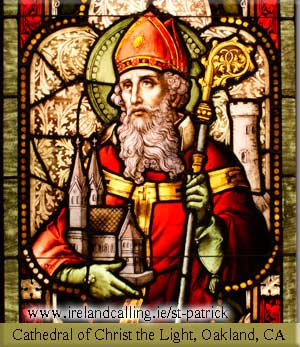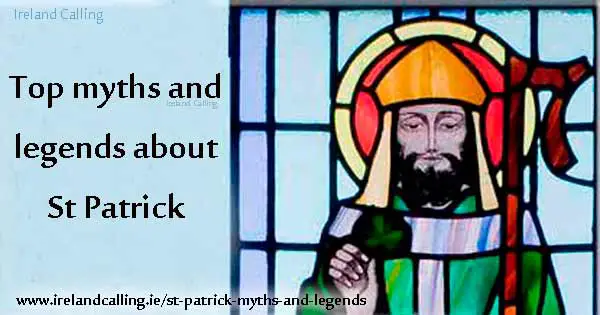The story of St Patrick is full of colourful myths and legends; many of them blending Christianity with characters and beliefs from ancient Celtic times.
More about St Patrick
What is the most important tale about St Patrick? Well there are many to choose from, here are some of the most popular stories about Ireland’s patron saint.
St Patrick defeats ancient Celtic heroes
One of the lesser known legends about St Patrick involves him taking part in a debate with the ancient Celtic hero Oisin.
In Celtic mythology, Oisin was one of the legendary Fianna – the ancient warriors led by the hero, Finn McCool (Fionn mac Cumhail).

Oisin fell in love with Niamh, a Celtic goddess and one of the queens of Tir na Nog – the land of eternal youth.
Oisin went to live with her in Tir na nOg and stayed there for several hundred years, never ageing and retaining all his youth and strength.
Eventually, he got homesick so Niamh gave him permission to return to Ireland on condition that he remained sitting on his magical horse at all times and did not touch the ground, even for a second.
His return to his native land was a disappointment for him because the friends and Fianna warriors he had known had been dead for centuries. He felt like a stranger in his native land.
He decided to return to Niamh but before he could do so, he saw a man struggling to lift a huge stone. Oisin stopped to help but as he strained to lift the stone, the strap on the saddle broke and he fell from the horse.
As soon as he touched the ground, he began to age rapidly, turning into a feeble old man.
As Oisin lay there dying, St Patrick walked by and stopped to talk. The discussion turned to the relative merits of their two religions and civilisations.
St Patrick gets the better of the debate. Oisin dies and St Patrick lives on, symbolising the triumph of Christianity over the pagan gods of the Celts.
In a similar story, taken from a 12th century document called, Acallam na Senóach, St Patrick chances upon Oisin and another Fianna warrior called Rónáin.
Again a debate takes place about the merits of Christianity over the Celtic, pagan lifestyle of the two warriors.
Both these stories, together with other variations, are likely to have been written by medieval monks who weren’t above creating propaganda that promoted Christian values over those of the ancient Celts.
This would have been a live issue for them because, although Ireland had become a Christian country at the time of St Patrick, many of the old Celtic beliefs and traditions lived on for many centuries afterwards.
St Patrick banishes snakes from Ireland

This is one of the best known St Patrick legends. The story goes that St Patrick had subjected himself to a 40-day fast on the top of the mountain now known as Croagh Patrick. As he came down after finishing his fast, he saw snakes gathering in front of him.
Perhaps the great man was in a bad mood from his fasting because, angered by the snakes’ look of evil and menace, he chased them into the sea and banished them forever. From that day forward, there were no snakes to be found in Ireland.
However, science says the absence of snakes in Ireland is down to Ice Age. The theory is that snakes started to migrate northwards from southern Europe as the last Ice Age ended and temperatures rose.
They reached as far as Britain but then melting ice caps created the Irish Sea, making it impossible for them to get to Ireland.
No one knows the origin of the story of Patrick and the snakes but some commentators have speculated that it originated with Irish monks several hundred years ago. The snakes are seen as symbol of the druids, the high priests of the pre-Christian world. In driving out the snakes, St Patrick is driving out the druids and in doing do, emphasises the triumph of Christianity over paganism.
St Patrick, shamrocks and the Holy Trinity
The concept of the Holy Trinity states that there is only one God but that God is made up of the God the father, God the son and God the Holy Spirit. It is a difficult concept, which has occupied the minds of theologians for 2,000 years.
Legend has it that the pagan people St Patrick was trying to convert just couldn’t understand this seemingly contradictory idea that God was both one and three at the same time.
St Patrick is said to have used the shamrock as a way of explaining the mystery to them. The shamrock was a single plant made up three leaves, each leaf represent one facet of God.
This is another St Patrick story that is likely to originated with Irish monks. The first known reference to it, according to the Oxford English dictionary, is 1726.
It’s widely thought that St Patrick is responsible for making the shamrock an important Irish symbol. In fact, it has been popular in Ireland for thousands of years. The ancient Celts believed many of the important aspects of life came in groups of three and the shamrock was used to symbolise this.
St Patrick creates the Celtic Cross
While preaching to the ancient Celts, St Patrick is said to have tried to make Christianity blend into their culture whenever possible. The story is that he saw that the Celts liked circular patterns and decided to blend those patterns with the Christian cross. The idea was that the Cross of the new faith would be more palatable to the Celts if it incorporated symbols from their own culture.
It’s a good story but unlikely to be true. The cross shape was popular with the Celts long before St Patrick. It was used to symbolise north, south, east and west… and also earth, fire, air and water.
The walking stick that became a living tree
Legend has it that St Patrick carried a walking stick made of wood from the ash tree. One day, after visiting his parent’s home in Britain, Patrick was taking the opportunity to preach to the people he met as he travelled back to Ireland.
Every time he stopped to preach, he thrust his walking stick into the ground. On one occasion he preached for so long that the stick developed roots and turned into a living tree. The place where it happened became known as Aspatria, meaning ash of Patrick.
It’s thought Irish monks are the most likely source of the story. They were always keen to promote Patrick as a saint, capable of producing miracles.
